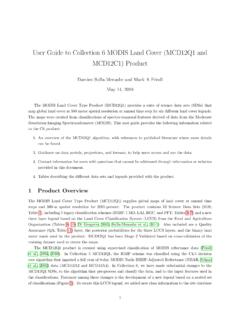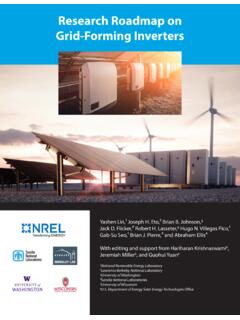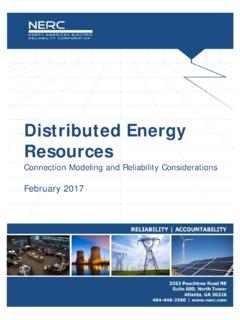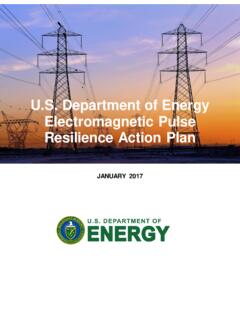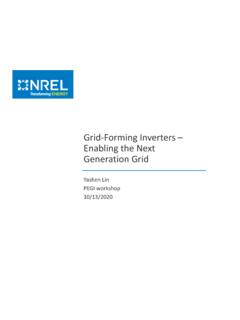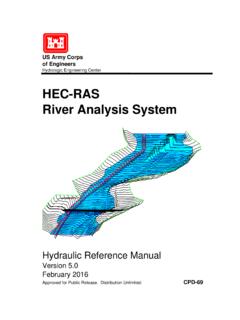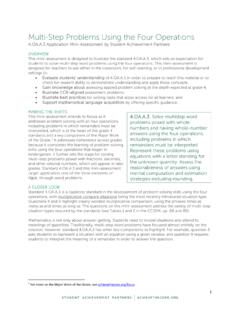Transcription of Smart Grid System Report - Energy
1 Smart grid System Report 2018 Report to Congress November 2018 United States Department of Energy Washington, DC 20585 Department of Energy | November 2018 Smart grid System Report 2018 | Page 2 Message from the Assistant Secretary I am pleased to present the 2018 Smart grid System Report , which is intended to provide a status of Smart grid deployments nationwide, resulting benefits, and the challenges yet remaining as we move forward with the modernization of the electric grid . It covers Smart grid developments since the prior Smart grid System Report submitted in August 2014. Over the past ten years, we have witnessed the accelerated deployment of technologies meant to improve the reliability and efficiency of utility operations, including the deployment of systems and practices to better engage utility customers in the management of Energy . Throughout this time, the Department has worked closely with both utilities and state regulators to convey best practices and enable a better understanding of the potential value of Smart grid systems.
2 However, we also recognize that the application of Smart grid technology depends largely on the specific needs of utilities, the preferences of their customers, and the respective policies of state and local jurisdictions. As a result, the pace and scope of Smart grid technology deployment is occurring differently across the country as local needs may dictate. Smart grid deployment is traditionally based on improving utility operations at both the transmission and distribution grid levels. Since 2010, we have seen accelerated deployments of advanced metering infrastructure, systems to improve voltage and outage management, and synchrophasor technology to enhance situational awareness. However, in the past five years, we are now witnessing the rapid adoption of distributed technologies, such as photovoltaic systems, and increasing ownership of these distributed assets by utility customers and third-party merchants. The proliferation of distributed devices is driven largely by state policies, lowering technology costs, and changing customer expectations and is not occurring consistently across the country.
3 Where it is happening, the rise in the number of distributed technologies and their ownership by entities other than utilities significantly increases the complexity of grid operations and poses challenges to traditional approaches for grid planning and market designs. Addressing the emerging complexity will require the deployment of advanced grid capabilities based largely on the application of Smart grid technology. This will include the continued development of a variety of technologies and improved strategies for grid sensing, information management, communications, control, and coordination. In this effort, we will also need to ensure the affordability, reliability, resilience, and security of the electric grid . The Department will continue to work closely with the electric utility industry and federal and state agencies to determine prudent approaches for deploying Smart grid technologies. Pursuant to statutory requirements, we are providing this Report to the following members of Congress: The Honorable Rodney Frelinghuysen Chairman, House Committee on Appropriations Department of Energy | November 2018 Smart grid System Report 2018 | Page 4 Executive Summary This Report conveys the status of Smart grid deployments across the nation, the capabilities they provide, and the challenges yet remaining as we move forward with the modernization of the electric grid .
4 Under Title XIII of the Energy Independence and Security Act of 2007 (Public Law 110-140), the DOE Office of Electricity is required to provide the status of Smart grid deployments and related challenges every two years. Over the past ten years, we have witnessed the accelerated deployment of technologies meant to improve the reliability and efficiency of utility operations, including the deployment of systems and practices to better engage utility customers in the management of Energy . This has included increased deployments of advanced metering infrastructure, systems to improve voltage and outage management, and synchrophasor technology to enhance situational awareness. However, more recently, we are witnessing the rapid adoption of distributed technologies, such as photovoltaic systems, and increasing ownership of these distributed assets by utility customers and third-party merchants. The effective integration of the grid with distributed assets presents a more complex and, potentially, transformative situation that will require the deployment of advanced grid capabilities based largely on the application of Smart grid technology.
5 The Smart grid is enabled by digital technology applied in devices and systems that allows for enhanced sensing and control of grid elements, more widespread information sharing and communication, more powerful computing, and finer control. The integration of digital structure with the physical structure of the grid is evolving rapidly due to the enhanced performance and declining costs of digital technology. Digital networks will eventually lead to greater levels of information exchange between utilities and their customers, as well as the convergence of the electric grid with other infrastructures such as buildings, transportation, and telecommunications. utilities invested approximately $144 billion in electricity generation, transmission, and distribution infrastructure in 2016 (the latest year of available data). Investor-owned utilities, serving 73% of electricity customers, spent $21 billion and $27 billion in 2016 on transmission and distribution delivery infrastructure, respectively.
6 Annual Smart grid investments rose 41% between 2014 and 2016 from $ billion to $ billion and are expected to rise to $ billion in 2024. The high capital costs and long lifespans of transmission and distribution infrastructure make it vitally important that investments made today can support an evolving grid for decades to come. This Report discusses in greater detail the key findings and recommendations given here: 1. Smart grid technology is being deployed to improve operational efficiency, reliability and resilience, but also to address the integration and utilization of distributed Energy resources (DERs) where they are being adopted. Department of Energy | November 2018 Smart grid System Report 2018 | Page 5 2. The integration of information technologies and operational technologies (IT/OT integration), cloud computing, and information networks represent major aspects of Smart grid deployment. Standards and protocols, such as IEC 61850 and IEEE 1547, are being developed and applied with significant efforts by the private sector and industry-led groups to ensure interoperability and security.
7 However, continued assessment by the federal government is recommended to ensure that interoperability and cybersecurity standards evolve and are implemented at a pace sufficient to support needed technology deployment. 3. A combination of federal and state policies, improvements in technology performance and costs, and customer preferences for generating and managing Energy is challenging traditional approaches for grid planning, operations, market design, and business models. These forces will require a transformation in the structure and functional capabilities of the electric grid and drive a need for holistic approaches in determining Smart grid technology deployment strategies. 4. In 2017, 39 states plus the District of Columbia took a total of 288 policy and deployment actions related to grid modernization, integrated resource planning, the application of DERs as non-wires alternatives, utility business models, rate reform, and the application of advanced metering infrastructure, Energy storage systems, and microgrids.
8 Progressive state policies, combined with favorable business incentives, have promoted the rapid adoption of DERs. Where this is occurring, the rate of technological change can outpace the ability of regulators and utilities to develop informed grid modernization strategies, especially because Smart grid implementation decisions need to enable an effective transition from legacy systems to grids with more advanced capabilities. 5. The increasing presence of renewable generation and the proliferation of customer- and merchant-owned DERs are introducing significantly greater levels of variability and uncertainty in both the supply of electricity and the demand for it. Generation and load profiles, which have been predictable in the past, can now vary instantaneously and are subject to the behavior of consumers where DERs are present. This new situation requires improved visibility into resources not owned by utilities, the ability to control and coordinate an increasing number of assets and endpoints, and grid systems that can readily adapt to conditions within sub-second timeframes.
9 6. State regulators and utilities will need comprehensive strategies for implementing Smart grid technologies to address this complexity. Toward this end, efforts by the Department to assist regulators and utilities in better understanding the structural and functional requirements for an advanced grid should continue, including advancing the practice of grid architecture as a discipline to impart a holistic planning capability. grid architecture helps to understand the interrelationships between the cyber, physical, industry, market, and regulatory structures to enable the implementation of scalable and coherent grid designs. Department of Energy | November 2018 Smart grid System Report 2018 | Page 6 7. Integrated planning approaches are needed to achieve a coordinated strategy for Smart grid technology deployment across the transmission, distribution and customer domains. This is important where high levels of DERs are deployed, as they present operational issues, yet also provide value in terms of generating capacity, Energy , frequency support, and other grid services.
10 Cross-jurisdictional coordination is required to effectively implement the appropriate mix of control schemes and market mechanisms. 8. As utilities, customers, and third-party merchants begin to share responsibilities in the provision of grid services, the traditional business model, especially at the distribution System level, will change. This will require re-defining respective roles and responsibilities; transitional strategies are currently being examined but do not yet exist due, in part, to the lack of fair compensation practices for both utilities and other participants. In addition, regulators, utilities, and the various participants will need to define the rules governing the interfaces between devices. These rules would cover physical, electrical, control, and communication requirements, along with business terms. Such coordination mechanisms will present requirements for Smart grid systems. 9. Increasing digital connections between utilities, customers, and various service providers creates new entry points that may expose the electric grid to new cyber risks.










